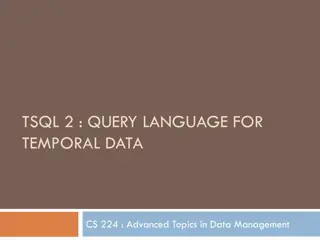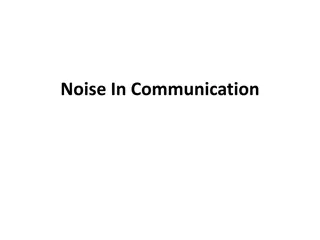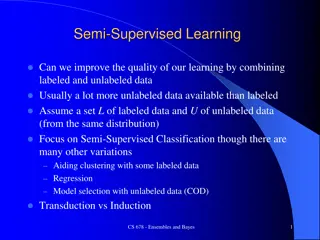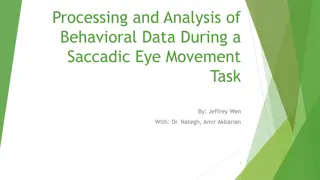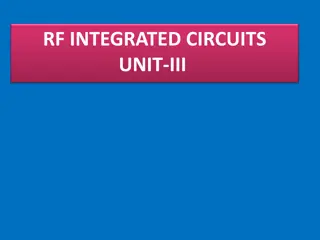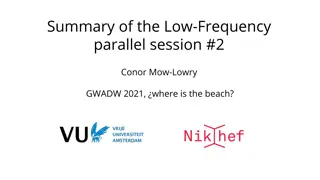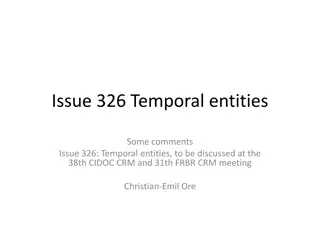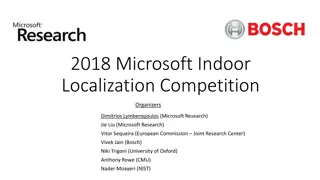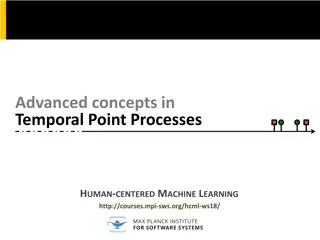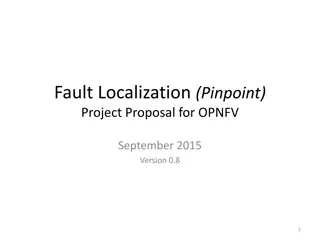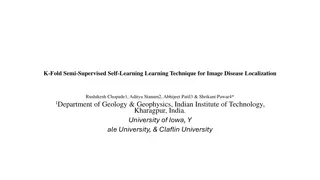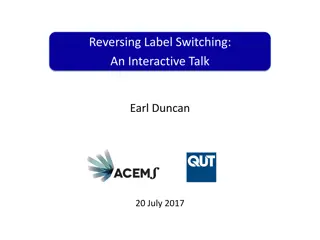Handling Label Noise in Semi-Supervised Temporal Action Localization
The Abstract Semi-Supervised Temporal Action Localization (SS-TAL) framework aims to enhance the generalization capability of action detectors using large-scale unlabeled videos. Despite recent progress, a significant challenge persists due to noisy pseudo-labels hindering efficient learning from abundant unlabeled videos. This paper delves into this critical issue, presenting a unified Noisy Pseudo-Label Learning framework to tackle location biases and category errors. The method features Noisy Label Ranking to rank pseudo-labels based on semantic confidence, Noisy Label Filtering to address class-imbalance issues, and Noisy Label Learning to penalize inconsistent predictions. These strategies enable noise-tolerant learning, facilitating better utilization of unlabeled video data. Experimental results on THUMOS14 and ActivityNet v1.3 validate the effectiveness of the proposed approach.
Download Presentation

Please find below an Image/Link to download the presentation.
The content on the website is provided AS IS for your information and personal use only. It may not be sold, licensed, or shared on other websites without obtaining consent from the author. Download presentation by click this link. If you encounter any issues during the download, it is possible that the publisher has removed the file from their server.
E N D
Presentation Transcript
Abstract Semi-Supervised Temporal Action Localization (SS-TAL) aims to improve the generalization ability of action detectors with large-scale unlabeled videos. Albeit the recent advancement, one of the major challenges still remains: noisy pseudo labels hinder efficient learning on abundant unlabeled videos, embodied as location biases and category errors. In this paper, we dive deep into such an important but understudied dilemma. To this end, we propose a unified framework, termed Noisy Pseudo-Label Learning, to handle both location biases and category errors. Specifically, our method is featured with (1) Noisy Label Ranking to rank pseudo labels based on the semantic confidence and boundary reliability, (2) Noisy Label Filtering to address the class-imbalance problem of pseudo labels caused by category errors, (3) Noisy Label Learning to penalize inconsistent boundary predictions to achieve noise-tolerant learning for heavy location biases. As a result, our method could effectively handle the label noise problem and improve the utilization of a large amount of unlabeled videos. Extensive experiments on THUMOS14 and ActivityNet v1.3 demonstrate the effectiveness of our method.
Abstract Semi-Supervised Temporal Action Localization (SS-TAL) aims to improve the generalization ability of action detectors with large-scale unlabeled videos. Albeit the recent advancement, one of the major challenges still remains: noisy pseudo labels hinder efficient learning on abundant unlabeled videos, embodied as location biases and category errors. In this paper, we dive deep into such an important but understudied dilemma. To this end, we propose a unified framework, termed Noisy Pseudo-Label Learning, to handle both location biases and category errors. Specifically, our method is featured with (1) Noisy Label Ranking to rank pseudo labels based on the semantic confidence and boundary reliability, (2) Noisy Label Filtering to address the class-imbalance problem of pseudo labels caused by category errors, (3) Noisy Label Learning to penalize inconsistent boundary predictions to achieve noise-tolerant learning for heavy location biases. As a result, our method could effectively handle the label noise problem and improve the utilization of a large amount of unlabeled videos. Extensive experiments on THUMOS14 and ActivityNet v1.3 demonstrate the effectiveness of our method.
Abstract 1. 2. 3. Semi-Supervised Temporal Action Localization (SS-TAL) aims to improve the generalization ability of action detectors with large-scale unlabeled videos. Albeit the recent advancement, one of the major challenges still remains: noisy pseudo labels hinder efficient learning on abundant unlabeled videos, embodied as location biases and category errors. In this paper, we dive deep into such an important but understudied dilemma. To this end, we propose a unified framework, termed Noisy Pseudo-Label Learning, to handle both location biases and category errors. Specifically, our method is featured with (1) Noisy Label Ranking to rank pseudo labels based on the semantic confidence and boundary reliability, (2) Noisy Label Filtering to address the class-imbalance problem of pseudo labels caused by category errors, (3) Noisy Label Learning to penalize inconsistent boundary predictions to achieve noise-tolerant learning for heavy location biases. As a result, our method could effectively handle the label noise problem and improve the utilization of a large amount of unlabeled videos. Extensive experiments on THUMOS14 and ActivityNet v1.3 demonstrate the effectiveness of our method.
Abstract Semi-Supervised Temporal Action Localization (SS-TAL) aims to improve the generalization ability of action detectors with large-scale unlabeled videos. Albeit the recent advancement, one of the major challenges still remains: noisy pseudo labels hinder efficient learning on abundant unlabeled videos, embodied as location biases and category errors. In this paper, we dive deep into such an important but understudied dilemma. To this end, we propose a unified framework, termed Noisy Pseudo-Label Learning, to handle both location biases and category errors. Specifically, our method is featured with (1) Noisy Label Ranking to rank pseudo labels based on the semantic confidence and boundary reliability, (2) Noisy Label Filtering to address the class-imbalance problem of pseudo labels caused by category errors, (3) Noisy Label Learning to penalize inconsistent boundary predictions to achieve noise-tolerant learning for heavy location biases. As a result, our method could effectively handle the label noise problem and improve the utilization of a large amount of unlabeled videos. Extensive experiments on THUMOS14 and ActivityNet v1.3 demonstrate the effectiveness of our method.
Introduction 1/7 Temporal Action Localization (TAL) aims at detecting action instances of interest in an untrimmed video by locating their temporal boundaries and recognizing their action categories. Most existing TAL methods rely on dense temporal annotations for the training videos. However, labeling human actions is very tedious and time-consuming. As a remedy, Semi- Supervised TAL (SS-TAL) requires only a few labeled videos in conjunction with a large amount of unlabeled videos. It has attracted growing attention in academia and industry.
Introduction 2/7 1. 2. Existing SS-TAL methods [12, 37, 28] are based on consistency regularization or self-training. Consistency-based methods [12, 37] aim to generate consistent action proposals for the same video subject to different augmentations, e.g., time warping [12] and temporal feature shift [37]. In contrast, the self-training-based method [28] achieves new state-of-the-art performance by alternating between pseudo-labeling and re-training. It focuses on designing a proposal-free framework to address proposal error propagation from [12, 37] but neglects the important role of pseudo labels. Albeit its advancement, label noise still remains a core challenge, hindering efficient learning on abundant unlabeled videos. From Figure 1, we can observe that label noise commonly leads to two intractable issues, i.e., location bias and category error, which become worse as the amount of labeled videos decreases. As a result, noisy pseudo labels will significantly degrade the performance of SS-TAL.
Introduction 2/7 Existing SS-TAL methods [12, 37, 28] are based on consistency regularization or self-training. Consistency-based methods [12, 37] aim to generate consistent action proposals for the same video subject to different augmentations, e.g., time warping [12] and temporal feature shift [37]. In contrast, the self-training-based method [28] achieves new state-of-the-art performance by alternating between pseudo-labeling and re-training. It focuses on designing a proposal-free framework to address proposal error propagation from [12, 37] but neglects the important role of pseudo labels. Albeit its advancement, label noise still remains a core challenge, hindering efficient learning on abundant unlabeled videos. From Figure 1, we can observe that label noise commonly leads to two intractable issues, i.e., location bias and category error, which become worse as the amount of labeled videos decreases. As a result, noisy pseudo labels will significantly degrade the performance of SS-TAL.
Introduction 3/7 1. 2. 3. In this paper, we propose a Noisy Pseudo-Label Learning (NPL) framework tailored for SS-TAL to combat detrimental label noise. It follows the self- training paradigm that alternates between pseudo-labeling and model training. But unlike all previous self-training methods, our NPL includes three novel components, termed Noisy Label Ranking, Noisy Label Filtering, and Noisy Label Learning, respectively, which alleviate the negative effects caused by location biases and category errors in a unified framework.
Introduction 4/7 First, Noisy Label Ranking aims to rank and select high quality pseudo labels based on both semantic confidence and boundary reliability. Classification scores have been widely used in self-training to measure the quality of pseudo labels, but they only reflect semantic confidence and fail to account for localization reliability. To close this gap, we explicitly model the localization reliability of a detected action instance in an unlabeled video as the variance of the boundary predictions from dense snippets within the action. We then introduce a new integrated metric of semantic confidence and boundary reliability to rank the pseudo labels.
Introduction 5/7 Second, Noisy Label Filtering aims at addressing the class-imbalance problem in noisy pseudo labels. Owing to the category error, the class- imbalance problem occurs regardless of whether pseudo labels are sampled based on a confidence threshold or the number of samples. The model will be dominated by redundant noisy pseudo labels in training, especially for the ones of category errors, and further harm its generalization ability. To address this issue, we introduce an adaptive filtering strategy to regularize the distribution of pseudo labels and adaptively assign class-balanced pseudo labels to unlabeled videos.
Introduction 6/7 Last, Noisy Label Learning aims to improve the robustness of training to location bias. While noisy label ranking and filtering can improve the quality of sampled pseudo labels, location bias will not be removed completely. Training on biased boundary labels hinders the convergence of the model and further impedes accurate action localization. To this end, we propose a noise-tolerant training algorithm based on an unsupervised temporal consistency loss, which penalizes inconsistent predictions from adjacent action frames.
Introduction 7/7 1. sota 2. 3. 4. The main contributions are summarized as follows: This paper introduces a Noisy Pseudo-Label Learning (NPL) framework tailored for SS-TAL, which handles both the location bias and category error in a unified framework. Extensive experiments conducted onTHUMOS14 [13] and ActivityNet v1.3 [2] demonstrate the effectiveness of the proposed method. We propose a Noisy Label Ranking method to rank and select high- quality pseudo labels based on a new integrated metric of semantic confidence and boundary reliability. We propose a Noisy Label Filtering method to tackle the largely ignored class-imbalance problem in pseudo labels based on a new adaptive filtering strategy. We introduce a Noisy Label Learning method, which adopts an unsupervised temporal consistency loss to penalize inconsistent predictions from adjacent frames for noise-tolerant learning.





